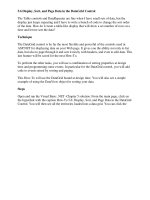Tài liệu Maternal, Infant, and Child Health in the United States 2010 pdf
Bạn đang xem bản rút gọn của tài liệu. Xem và tải ngay bản đầy đủ của tài liệu tại đây (8.83 MB, 128 trang )
March of Dimes Foundation
Data Book for Policy Makers
Maternal, Infant, and Child Health
in the United States
20 1 0
©2009 by the March of Dimes. Permission to copy, disseminate or otherwise
use information from the Data Book for Policy Makers is granted as long as
appropriate acknowledgment is given.
Prepared by:
Office of Government Affairs
March of Dimes
1146 19th Street, NW, Sixth Floor
Washington, DC 20036
Telephone (202) 659-1800
Fax (202) 296-2964
For additional copies:
March of Dimes
P.O. Box 932852
Atlanta, GA 31193-2852
Phone (800) 367-6630
marchofdimes.com
Item number 50-2461-10
The March of Dimes Data Book for
Policy Makers: Maternal, Infant, and
Child Health in the United States
2010 provides national and state
data highlighting infant mortality,
birth defects, preterm and low
birthweight births, health insurance
coverage for women and children,
and prevention strategies. This
easy-to-use resource guide is aimed
at public policy makers and others
seeking quick facts at their fingertips.
Readers interested in more detail
and regular updates of many of
the data presented in this book
should visit PeriStats, the March of
Dimes interactive data resource at
marchofdimes.com/peristats.
Except where noted, information
in this Data Book is for the United
States. Where possible, data for
Puerto Rico are included.
The March of Dimes Data Book
for Policy Makers was produced by
Colleen Sonosky, Kate Morrand,
and Marina L. Weiss of the Office
of Government Affairs. Rebecca
Russell, Todd Dias, Hui Zheng,
and Vani Bettegowda of the March
of Dimes Perinatal Data Center
prepared much of the data. Don
Komai of Watermark Design and
Chintan Parikh from Publishing
Resources provided services to
assist the March of Dimes with the
production of the publication.
The March of Dimes is a national
voluntary health agency founded
in 1938 by President Franklin D.
Roosevelt to support research and
services related to polio. Today,
the Foundation works to improve
the health of women, infants and
children by preventing birth defects,
premature birth and infant mortality
through research, community
services, education and advocacy.
The March of Dimes is a unique
partnership of scientists, clinicians,
parents, members of the business
community and other volunteers
affiliated with chapters in all 50
states, the District of Columbia, and
Puerto Rico.
We trust this Data Book and other
March of Dimes resources that can
be found at www.marchofdimes.
com (Spanish language site www.
nacersano.org) will be helpful as we
work together toward the day when
every baby is born healthy.
Dr. Bruce C. Vladeck, Chair
National Public Affairs Committee
March of Dimes
Dr. Jennifer L. Howse, President
March of Dimes
About PeriStats
PeriStats, the March of Dimes interactive web resource (marchofdimes.
com/peristats) offers the latest data on maternal, infant, and child health at
national, state, and local levels. Users – from the general public to policy
makers, researchers, providers, and students – will find the site comprehensive and easy to use.
Look for the PeriStats logo
on pages throughout the
Data Book for Policy Makers. It’s a signal that more detailed – and perhaps
more current information is available on the website.
Updated at least annually, PeriStats covers data for multiple years for topics
like birth rates, infant mortality, prematurity, and low birthweight; tobacco,
alcohol, and illicit drug use; cesarean section rates; newborn screening; and
health insurance coverage. Information by race, ethnicity, and maternal age is
also available for many of these indicators.
Users can compare data for counties, states, and the United States and can
choose various output formats, including graphs, maps, tables, and slides
which they can use in reports or presentations.
Together, PeriStats and the Data Book are powerful tools for helping inform
policy to improve maternal, infant, and child health in the United States.
marchofdimes.com/peristats
Contents
Maternal, Infant, and Child Health Objectives for 2010 1
On an average day in the United States 2
Quick stats for the United States 3
Infant and Maternal Mortality
Infant Mortality in the United States 6
Infant Mortality and Race/Ethnicity of Mother 8
Leading Causes of Infant Mortality10
Maternal Mortality12
Birth Defects
Incidence of Birth Defects16
Birth Defects Monitoring Programs18
Newborn Screening20
Newborn Screening: Categories of Disorders22
Preterm and Low Birthweight Births
Preterm Births26
Prematurity and Low Birthweight28
Risk of Preterm Births30
Prematurity and Race/Ethnicity of Mother32
Costliness of Preterm and Low Birthweight Babies34
Prevention
Importance of Prenatal Care38
Patterns of Prenatal Care39
Benefits of Folic Acid40
Smoking During Pregnancy42
Alcohol and Other Drug Use44
Obesity46
Childhood Immunization48
Health Insurance
Health Insurance and Access to Care50
Health Insurance Coverage for Women of Childbearing Age52
Health Insurance Coverage for Children54
Medicaid’s Role in Maternal and Child Health56
Children’s Health Insurance Program58
Medicaid and CHIP: Eligibility and Enrollment60
State Data
State Infant Mortality Rates, 2003-2005 Average65
Live Births, by State, 200668
Newborn Screening Requirements, by State, 2009 70
Preterm and Low Birthweight Births72
Prenatal Care84
Health Insurance90
Immunizations
1
11
Newborn Screening Terms: A Glossary 112
Contents (continued)
Data Sources
116
Figures and Summary Tables
Infant Mortality, 1950-2005 7
Infant Mortality, by Region, 2005 7
Infant Mortality, by Race/Ethnicity of Mother, 2005 9
Infant Mortality, by Hispanic Ethnicity of Mother, 2005 9
Leading Causes of Neonatal and Infant Mortality, 2005 11
Maternal Mortality, by Race, 1970-2006 13
Hospital Costs of Birth Defects, 2004 17
State Activities in Birth Defects Monitoring, 2009 19
Organizational Location of Birth Defects Programs, 2009 19
Funding Sources for Birth Defects Programs, 2009 19
State Newborn Screening Requirements, 2009: A Summary 21
Preterm and Very Preterm Births, 1996-2006 27
Percent Distribution of All Preterm Births, 2006 27
Incidence of Preterm and Low Birthweight Births, 2006 29
Low and Very Low Birthweight Births, 1996-2006 29
Preterm and Very Preterm Births, by Age of Mother, 2006 31
Preterm Births: Singleton, Twin, and Higher Order, 2006 31
Preterm and Very Preterm Births, by Race/Ethnicity of Mother, 2006 33
Preterm and Very Preterm Births, by Hispanic Ethnicity of Mother, 2006 33
Average Length of Stay and Average Medical Costs Among Preterm
and Term Births, 2005 35
Conditions with the Highest Inpatient Hospital Costs, 2007 35
Awareness of Folic Acid Benefits Among Women of Childbearing Age,
1995 and 2008 41
Pregnant and Nonpregnant Women Reporting Smoking During the
Past Month, 2007-2008 43
State Medicaid Coverage: Smoking Cessation Treatments for
Pregnant Women, 2006 43
Women Ages 18-44 Reporting Binge Drinking During Past
Month, 2003-2008 45
Obesity Among Women Ages 18-44, 1998-2008 47
Children with No Usual Source of Medical Care, by Type of Insurance
Coverage, 2006-2007 51
Women Ages 15-44, by Type of Health Insurance Coverage, 2008 53
Women Ages 15-44 Who Are Uninsured, by Race/Ethnicity, 2008 53
Children Under Age 19, by Type of Health Insurance Coverage, 2008 55
Children Under Age 19 Who Are Uninsured, by Race/Ethnicity, 2008 55
Medicaid Enrollment and Expenditures, by Enrollee Characteristics, 2006 57
Family Planning Waiver Programs, by State, 2007 57
Children’s Health Insurance Program Enrollment, 2001-2008 59
States with Presumptive or Continuous Eligibility Under Medicaid and
CHIP, 2007-2009 61
State-by-State Data and Tables
State Infant Mortality Rates, 2003-2005 Average 65
Infant Mortality Rates, by States, 2003-2005 Average 66
Live Births, by State, 2006 68
Newborn Screening Requirements, by State, 2009 70
Preterm Births, by State, 2006 72
Late Preterm Births, by State, 2006 74
Very Preterm Births, by State, 2006 76
Low Birthweight Births, by State, 2006 78
Very Low Birthweight Births, by State, 2006 80
Preterm Birth Rates, by State, 2006 82
Children’s Health Insurance Program, by Type of Program, 2009 83
Births to Women Who Received Early Prenatal Care, by State, 2006
(1989 Birth Certificate Revision)
84
Births to Women Who Received Early Prenatal Care, by State, 2006
(2003 Birth Certificate Revision)
85
Births to Women Who Received Late or No Prenatal Care, by State, 2006
(1989 Birth Certificate Revision)
86
Births to Women Who Received Late or No Prenatal Care, by State, 2006
(2003 Birth Certificate Revision)
87
Births to Women Who Received Adequate or Adequate-Plus Prenatal Care,
by State, 2006 (1989 Birth Certificate Revision)
88
Births to Women Who Received Adequate or Adequate-Plus Prenatal Care,
by State, 2006 (2003 Birth Certificate Revision) 89
Women Ages 15-44 Without Health Insurance, by State, 2006-2008 Average 90
Children Under Age 19 Without Health Insurance, by State, 2006-2008 Average 92
Income Eligibility Thresholds for Pregnant Women and for Children
Under Medicaid, by State, 2009 94
Income Eligibility Thresholds for Pregnant Women and for Children
Under CHIP , by State, 2009 96
Presumptive and Continuous Eligibility Under Medicaid and CHIP,
by State, 2007-2009 98
Medicaid Enrollees, by Select Characteristics, by State, Fiscal Year 2006100
Medicaid Expenditures, by Enrollee Characteristics, by State, Fiscal Year 2006102
Stand-Alone and Medicaid Expansion CHIP Enrollees, by State, 2007-2008104
Children’s Health Insurance Program Federal Allotments, by State,
Fiscal Year 2009106
Federal Matching Rates for Medicaid and CHIP, by State, Fiscal Year 2010108
Births Funded by Medicaid, by State, 2003 109
Medicaid Coverage of Smoking Cessation Treatments, by State, 2006110
Percent of Children 19-35 Months with Up-to-Date Immunizations, 2008111
Maternal, Infant, and Child Health Objectives
for 2010
n
Healthy People 2010, a series of national health objectives
to be achieved by the year 2010, was released by the
U.S. Department of Health and Human Services (HHS)
in January 2000. These objectives are being used as a
benchmark for measuring progress in health promotion
and disease prevention.
n
The broad goals of this initiative are to increase the
quality and years of healthy life and eliminate racial and
ethnic disparities in health status.
n
A number of the Healthy People 2010 objectives concern
maternal, infant, and child health. Among them are
efforts to:
q
q
q
n
Reduce rates of infant and maternal mortality, preterm
and low birthweight births, and birth defects
Increase the proportion of women receiving early and
adequate prenatal care
Ensure appropriate newborn screening and follow-up
testing and care
Many relevant objectives are referred to in this data book.
More detailed information about the initiative is at the
website healthypeople.gov.
E v e r y 1 0 y ea r s , H H S assesses and r epo r ts on scientific
insights and l essons l ea r ned f r om the past decade ,
a l ong with new k now l edge of c u r r ent data , t r ends ,
and inno v ations . H ea l th y P eop l e 2 0 2 0 wi l l r ef l ect
assessments of ma j o r r is k s to hea l th and we l l ness ,
changing p u b l ic hea l th p r io r ities , and eme r ging iss u es
r e l ated to o u r nation ’ s hea l th p r epa r edness and p r e v ention . F o r info r mation on the de v e l opment of the
r e v ised o r new ob j ecti v es set fo r H ea l th y P eop l e 2 0 2 0 ,
see hea l th y peop l e . go v / hp 2 0 2 0 /
1
On an average day in the United States...
11,686
1,487
babies are born
babies are born preterm
(less than 37 completed weeks gestation)
964
babies are born low birthweight
329
babies are born with a birth defect*
237
babies are born very preterm
173
babies are born very low birthweight
78
(less than 2,500 grams, or 5 1/2 pounds)
(less than 32 completed weeks gestation)
(less than 1,500 grams, or 3 /3 pounds)
1
babies die before reaching their first
birthday
* Based on Centers for Disease Control and Prevention estimate of at least 120,000 babies born
annually with major structural birth defects.
Note: Numbers are approximations.
Source: National Center for Health Statistics, 2006 final natality data and 2005 period linked birth/infant
death data. Prepared by the March of Dimes Perinatal Data Center, 2009.
2
March of Dimes
Quick stats for the United States...
n
About every seven seconds, a baby is born.
n
Every hour, about three babies die.
n
African-American infants are more than twice as likely
as white infants to die before their first birthday.
n
n
Birth defects are the leading cause of infant mortality,
accounting for one in five infant deaths.
Each year, about 3,000 pregnancies are affected with birth
defects of the brain and spinal cord.
About every four and a half minutes, a baby is born with
a birth defect.*
n
About one in eight infants is born preterm.
(less than 37 completed weeks gestation)
n
About every one and a half minutes, a low birthweight
baby is born.
(less than 51/2 pounds)
n
Prematurity/low birthweight is the second leading cause
of all infant deaths and the leading cause of infant deaths
among African Americans.
n
Every year, about 4,900 babies are born weighing less than
one pound.
n
About every minute, a baby is born to a teen mother.
n
* Based on Centers for Disease Control and Prevention estimate of at least 120,000 babies born annually
with major structural birth defects.
Source: National Center for Health Statistics, 2006 final natality data and 2005 period linked birth/infant
death data. Prepared by the March of Dimes Perinatal Data Center, 2009.
March of Dimes
3
Infant and
Infant and
Maternal
Maternal
Mortality
Mortality
Infant Mortality in the United States
Even though infant mortality in the United States dropped
dramatically in the past century, significant room for
improvement remains.
q
q
q
The infant mortality rate remained relatively stable
over the last several years.
More than 28,000 infants died before their first
birthdays in 2005—a rate of 6.9 deaths per 1,000
live births.
In 2005, the infant mortality rate was highest in the
southern region of the United States.
Source: National Center for Health Statistics, 2005 period linked birth/infant death data. Prepared by the March of Dimes
Perinatal Data Center, 2009.
I nfant M o r ta l it y
r efe r s to death
u nde r age one .
T he infant mo r ta l it y r ate is the
n u mbe r of infant
deaths pe r 1 , 0 0 0
l i v e bi r ths .
6
March of Dimes
Infant Mortality, 1950-2005
Deaths per 1,000 live births
30
25
20
29.2
26.0
20.0
15
12.6
10
10.6
9.2
5
7.6
6.9
6.8
7.0
6.8
6.8
6.9
4.5
0
1950 1960 1970 1980 1985 1990 1995 2000 2001 2002 2003 2004 2005
Source: National Center for Health Statistics, 1950-1990 final mortality data, 1995-2005 period linked
birth/infant death data. Prepared by March of Dimes Perinatal Data Center, 2009.
2010
Year
Goal
Infant Mortality by Region, 2005
Deaths per 1,000 live births
10
9
8
7
7.8
7.3
6.0
6
5.6
5
4
3
2
1
0
Midwest
Northeast
South
West
Source: National Center for Health Statistics, 2005 period linked birth/infant death data.
Prepared by the March of Dimes Perinatal Data Center, 2009.
March of Dimes
7
Infant Mortality and Race/Ethnicity of Mother
n
African-American infants are nearly two and a half times
as likely as white infants to die in the first year of life.
n
Excluding babies of Hispanic origin, the 2005 infant
mortality rate for those born to black mothers was
13.6 per 1,000 live births, compared with 5.8 for whites,
8.3 for Native Americans, and 4.8 for Asian/Pacific
Islanders.
n
For Hispanics, the 2005 infant mortality rate was
5.6 per 1,000 live births. Within this group, Puerto Rican
mothers had the highest rate of 8.3.
O ne H ea l th y P eop l e
2 0 1 0 O b j ecti v e is
to r ed u ce the r ate
of infant deaths
fo r a l l r acia l /
ethnic g r o u ps to
4 . 5 pe r 1 , 0 0 0 l i v e
bi r ths .
8
March of Dimes
Infant Mortality,
by Race/Ethnicity of Mother, 2005
Deaths per 1,000 live births
16
14
13.6
12
10
8.3
8
6
6.9
5.8
5.6
4.8
4.5
4
2
0
White
Black
Native
American
a
Asian/
Pacific
Islander
All Races/ Year
Ethnicities 2010
Goal
Hispanic
b
a
Native American includes American Indian, Eskimo, and Aleut.
People of Hispanic origin may be of any race; racial categories displayed here are non-Hispanic.
Source: National Center for Health Statistics, 2005 period linked birth/infant death data.
Prepared by the March of Dimes Perinatal Data Center, 2009.
b
Infant Mortality,
by Hispanic Ethnicity of Mother, 2005
Deaths per 1,000 live births
16
14
12
10
8.3
8
6
6.4
5.5
4.4
4
5.6
4.7
2
0
Mexican
Puerto
Rican
Cuban
Central
or South
American
Other
Hispanic
Total
Hispanic
Source: National Center for Health Statistics, 2005 period linked birth/infant death data.
Prepared by the March of Dimes Perinatal Data Center, 2009.
March of Dimes
9
Leading Causes of Infant Mortality
n
n
n
n
n
For more than 20 years, birth defects have been the
leading cause of infant mortality (death in the first year
of life). By contrast, prematurity/low birthweight is the
most common cause of neonatal mortality (death in the
first month of life).
Birth defects and prematurity/low birthweight together
were responsible for 36 percent of all infant deaths and
45 percent of all neonatal deaths in 2005.
Birth defects alone were responsible for nearly 21 percent
of neonatal deaths in the same year.
The leading cause of infant death differed by race.
Among non-Hispanic whites, it was birth defects. Among
non-Hispanic blacks, it was prematurity/low birthweight.
The rate of deaths due to prematurity/low birthweight
for non-Hispanic black infants was four times that for
non-Hispanic white infants (305 versus 76 per 100,000
live births.)
H ea l th y P eop l e 2 0 1 0 has se v e r a l
ob j ecti v es to r ed u ce the r ate of
infant deaths , inc l u ding :
n F o r bi r th defects , l owe r the
infant death r ate to 1 . 1 f r om
1.6 (1998)
n F o r s u dden infant death
s y nd r ome , o r S I D S , L O W E R T H E
I N F A N T D E A T H R A T E T O 0 . 2 5 F R O M
0.72 (1998)
( R AT E S A R E P E R 1 , 0 0 0 L I V E B I R T H S . )
10
March of Dimes
Leading Causes of Neonatal and
Infant Mortality, 2005
Percent of
Neonatal
Deaths
Percent of
Infant
Deaths
Prematurity/low birthweight
24.4
16.6
Birth defects
20.9
19.6
Maternal complications
9.3
6.2
Placenta/cord complications
5.7
3.9
Respiratory distress syndrome
4.4
3.0
Sudden infant death syndrome 1.1
7.9
Note: Neonatal death occurs in the first month of life (28 days). Infant death occurs during the first year of life.
Source: National Center for Health Statistics, 2005 period linked birth/infant death data. Prepared by the
March of Dimes Perinatal Data Center, 2009.
March of Dimes
11
Maternal Mortality
n
After a marked decline, the rate of maternal deaths in the
United States has not substantially improved since the 1980s.
n
There were 13.3 maternal deaths per 100,000 live births
in 2006, according to vital statistics data. This figure may
be an undercount, however. The actual maternal mortality
rate is estimated to be 1.3 to 3 times higher.
n
In 2006, African Americans were nearly three and a
half times as likely as whites to die from pregnancy
complications and childbirth.
n
Further reductions in maternal mortality are possible,
given that the World Health Organization estimates that
33 countries have achieved lower maternal mortality levels
than the United States.
q
q
Experts estimate that up to half of all maternal deaths
in this country could be prevented through a variety
of interventions, including early diagnosis and
appropriate medical care of pregnancy complications.
One Healthy People 2010 objective is to lower the
maternal mortality rate to 3.3 deaths per 100,000
live births.
12
Of the more than 4 million
women who give birth each year
in the United States, at least 30
percent have a pregnancy-related
complication before, during, or
after delivery. Even when they
do not result in death, these
complications may cause long-term
health problems.
A mate r na l death
Source: Maternal mortality rates from the National Center for
Health Statistics, 2009a. International ranking from the World Health
Organization, 2007. All other information from the Center for Disease
Control and Prevention, 1998 and 1999a.
n
accidenta l o r
is defined as one
that occ u r s d u r ing
p r egnanc y o r
within 4 2 da y s of the
end of a p r egnanc y .
I r r especti v e of the
d u r ation and site of
the p r egnanc y , f r om
an y ca u se r e l ated to
o r agg r a v ated b y a
woman ’ s p r egnanc y ,
b u t not f r om
incidenta l ca u ses
Maternal Mortality, by Race, 1970 2006
–
Maternal deaths per 100,000 live births
70
60
50
40
30
20
10
0
2000
2006
Total
Black
White
Note: Rates from 1970-1988 are based on race of child. Rates after 1988 are based on race of mother.
Source: National Center for Health Statistics, 2009a.
March of Dimes
13
Birth Defects
Incidence of Birth Defects
n
Each year, an estimated 120,000 babies are born with
major structural birth defects.
n
One in five infant deaths is due to birth defects, making
them the leading cause of infant mortality
n
Birth defects rank second in leading causes of death among
1- to 4-year olds and fifth among 5- to 14-year olds.
n
Birth defects of the heart and circulatory system are the
most common, affecting roughly 1 in 115 newborns.
n
Hospital costs for stays due to birth defects totaled
$2.6 billion for all birth defects and all ages in 2004.
More than half of all hospital costs were related to
cardiac and circulatory birth defects. In 2004, a birth
defect hospital admission was more than twice as costly
as all other hospital admissions averaging $18,600.
n
Severe birth defects may require special lifelong medical
treatment. Because many conditions cannot be fully
corrected, birth defects are a major cause of childhood
and adult disability.
Sources: Infant deaths from birth defects from the National Center for Health Statistics, 2005 period linked/infant death
data. Childhood deaths from birth defects from the National Center for Health Statistics, 2006 final mortality data.
Hospital costs from Russo, CA and Elixhauser, A, 2007.
16
March of Dimes
Hospital Costs of Birth Defects, 2004
Principal
Diagnosis
Total # of
Hospital Stays
% of All Stays
for Birth Defects
Mean Costs
(dollars)
Aggregate Costs
(dollars)
All cardiac and
circulatory congenital
anomalies
46,500
33.5%
$29,600
1,368,822,600
$
All digestive
congenital anomalies
25,800
18.5%
$11,700
$303,173,100
All genitourinary
congenital anomalies
12,900
9.3%
$8,900
$114,709,700
All nervous system
congenital anomalies
6,900
5.0%
$16,200
$112,164,200
Cleft lip with or without
cleft palate
4,900
3.6%
$5,500
$27,155,800
Congenital anomalies
of skull and facial bones
3,700
2.6%
$16,800
$61,329,500
Foot deformities
2,900
2.1%
$5,900
$16,873,900
Cleft palate without
cleft lip
2,900
2.1%
$5,400
$15,506,700
139,000
100%
All birth defects*
$18,600 $2,566,067,700
* Includes birth defects not shown.
Source: Russo, CA and Elixhauser, A, 2007.
March of Dimes
17









